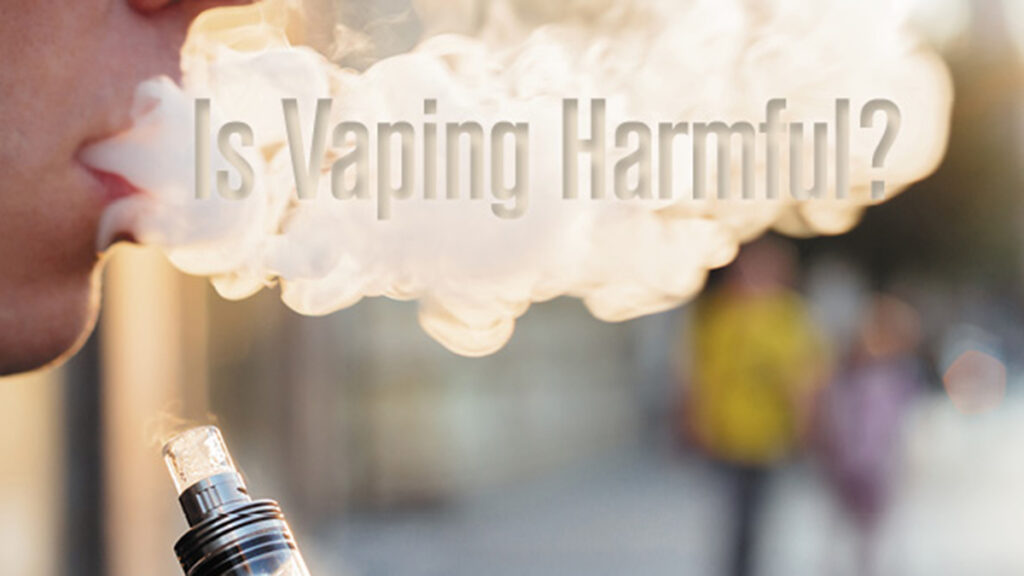Is vaping bad?

While vaping may appear less harmful on the surface, it is not without its drawbacks and potential health consequences. Here, we delve into the science behind vaping to uncover the truth behind its perceived safety.
- Chemical Composition:
Electronic cigarettes work by heating a liquid, usually containing nicotine, flavorings, and other chemicals, to produce an aerosol that is inhaled by the user. While e-cigarettes do not contain many of the harmful chemicals found in traditional cigarettes, such as tar and carbon monoxide, they still expose users to potentially harmful substances, including heavy metals and volatile organic compounds.
- Nicotine Addiction:
Nicotine, the addictive substance found in tobacco, is present in most vaping products, albeit in varying concentrations. While some e-cigarettes offer nicotine-free options, many users continue to use vaping as a means of satisfying their nicotine cravings, perpetuating their addiction.
- Health Risks:
Despite claims that vaping is safer than smoking, research suggests that it is not without risks. Studies have linked vaping to respiratory issues, cardiovascular problems, and adverse effects on lung function. Additionally, the long-term health effects of vaping are still not fully understood, as the industry is relatively young compared to traditional tobacco use.
- Youth Epidemic:
One of the most concerning aspects of vaping is its appeal to young people. The availability of flavored e-liquids and sleek, discreet devices has contributed to a surge in vaping among adolescents and teenagers. This trend is troubling, as nicotine exposure during adolescence can harm brain development and increase the likelihood of addiction later in life.
- Regulatory Challenges:
The rapid growth of the vaping industry has outpaced regulation, leaving consumers vulnerable to misleading marketing tactics and substandard products. While some countries have implemented restrictions on vaping, such as flavor bans and age restrictions, enforcement remains a challenge.
- Smoking Cessation Tool or Gateway to Tobacco Use?
Proponents of vaping argue that it serves as an effective smoking cessation tool, helping smokers transition away from traditional cigarettes. While some individuals have successfully used vaping to quit smoking, others have found themselves dual-users or have returned to smoking altogether. Furthermore, there is concern that vaping may serve as a gateway to tobacco use, particularly among young people.
Is vaping better than smoking cigarettes?
Vaping has emerged as a popular alternative to smoking cigarettes, particularly among individuals looking to quit or reduce their tobacco intake. Advocates of vaping often tout it as a safer alternative to traditional smoking, citing reduced exposure to harmful chemicals and fewer health risks. However, the debate over whether vaping is truly better than smoking cigarettes remains contentious, with conflicting evidence and ongoing research shaping public perception.
The Rise of Vaping:
Vaping, the act of inhaling and exhaling aerosol produced by an electronic cigarette or similar device, has gained momentum as a smoking cessation aid and recreational activity. Unlike traditional cigarettes, which combust tobacco to release nicotine and other chemicals, e-cigarettes heat a liquid solution containing nicotine, flavorings, and other additives to create an aerosol that users inhale.
Advocates argue that vaping offers several potential benefits over smoking cigarettes:
- Reduced Exposure to Harmful Chemicals:
Vaping eliminates combustion, thereby reducing exposure to many of the toxic chemicals found in cigarette smoke, such as tar and carbon monoxide. While e-cigarette aerosol still contains some harmful substances, studies suggest that it contains fewer toxins than tobacco smoke.
- Potential for Harm Reduction:
Some smokers view vaping as a less harmful alternative that may help them quit or significantly reduce their cigarette consumption. E-cigarettes allow users to control their nicotine intake, potentially weaning them off traditional cigarettes and lowering their overall health risks.
- Less Secondhand Smoke:
Vaping produces vapor rather than smoke, which dissipates more quickly and may pose fewer risks to bystanders. This aspect of vaping has led to its acceptance in certain public spaces where smoking is prohibited.
The Controversy Surrounding Vaping:
Despite these perceived benefits, vaping is not without its critics, who raise several concerns about its safety and long-term health effects:
- Unknown Health Risks:
Vaping is a relatively new phenomenon, and the long-term health effects of e-cigarette use remain uncertain. While research indicates that vaping is likely less harmful than smoking cigarettes, the full spectrum of health risks associated with vaping has yet to be fully understood.
- Nicotine Addiction:
E-cigarettes still deliver nicotine, an addictive substance that can have adverse effects on the developing brains of adolescents and young adults. Critics worry that vaping may normalize nicotine use and serve as a gateway to smoking among non-smokers, particularly youth.
- Quality Control and Regulation:
The rapidly evolving landscape of vaping products has raised concerns about product safety and quality control. Reports of contaminated e-liquids, faulty devices, and misleading marketing tactics underscore the need for stricter regulation and oversight within the vaping industry.
Navigating the Decision:
For individuals weighing the decision between vaping and smoking cigarettes, it’s essential to consider their personal health goals, habits, and risk factors. While vaping may offer certain advantages over traditional smoking, it is not a risk-free or universally recommended alternative.
Smokers looking to quit should explore a range of cessation options, including FDA-approved medications, counseling, and behavioral support programs. While some individuals may find success with vaping as a cessation aid, others may benefit from alternative approaches tailored to their needs and preferences.
Is vaping better than cigarettes for COPD?
Chronic Obstructive Pulmonary Disease (COPD) is a progressive respiratory condition that affects millions of people worldwide. It encompasses diseases like chronic bronchitis and emphysema, characterized by airflow obstruction and breathing difficulties.
Vaping vs. Cigarettes: Which is Better for COPD?
Smoking tobacco is a well-established risk factor for COPD, exacerbating symptoms and hastening the progression of the disease. With the advent of vaping, many smokers have turned to e-cigarettes as a potentially “safer” alternative. But does vaping truly offer any advantages over traditional cigarettes for individuals with COPD?
Understanding the Risks:
- Cigarette Smoking and COPD:
The link between cigarette smoking and COPD is undeniable. The toxins present in cigarette smoke cause inflammation, damage to lung tissue, and narrowing of the airways, leading to the hallmark symptoms of COPD such as coughing, wheezing, and shortness of breath. Moreover, smoking cessation is often recommended as a crucial step in managing COPD to slow down its progression and reduce exacerbations.
- Vaping and COPD:
Vaping, or the use of electronic cigarettes, involves inhaling aerosolized liquid nicotine, flavorings, and other chemicals. While vaping may eliminate many of the harmful substances found in cigarette smoke, it is not without its risks. E-cigarette vapor contains potentially harmful chemicals, including fine particles, volatile organic compounds, and heavy metals, which can irritate the lungs and exacerbate respiratory symptoms.
The Debate:
- Reduced Exposure:
Proponents of vaping argue that e-cigarettes deliver nicotine without the combustion process involved in smoking, thus reducing exposure to harmful toxins. Some studies suggest that switching from cigarettes to e-cigarettes may lead to improvements in respiratory symptoms and lung function, although long-term data on the safety and efficacy of vaping for COPD are limited.
- Unregulated Market:
One of the challenges in assessing the benefits of vaping for COPD lies in the lack of regulation and standardization within the vaping industry. The wide variety of e-cigarette devices, e-liquid formulations, and vaping practices make it difficult to draw definitive conclusions about its effects on respiratory health.
Considerations for COPD Patients:
- Quitting Smoking:
The first-line recommendation for individuals with COPD remains smoking cessation. Quitting smoking, with or without the use of nicotine replacement therapies or cessation aids, is essential for slowing disease progression and improving overall health outcomes.
- Consultation with Healthcare Providers:
COPD management should always be guided by healthcare professionals who can provide personalized recommendations based on individual patient factors. Healthcare providers can offer support, resources, and smoking cessation programs tailored to the specific needs of COPD patients.
Is vaping better than cigarettes when pregnant?
Pregnancy is a critical time for both the mother and the developing baby, and it’s essential to prioritize health and well-being during this period. For women who smoke or are considering alternatives like vaping, understanding the potential risks and benefits is crucial.
Vaping vs. Cigarettes During Pregnancy: Understanding the Risks and Considerations
In this article, we delve into the comparison between vaping and cigarette smoking during pregnancy, aiming to provide clarity on the subject.
The Risks of Cigarette Smoking During Pregnancy:
Cigarette smoking during pregnancy is widely recognized as harmful to both the mother and the unborn child. The chemicals in cigarette smoke, such as nicotine, carbon monoxide, and tar, can significantly impact fetal development and increase the risk of complications. Some of the potential risks associated with smoking during pregnancy include:
- Low birth weight:
Smoking can restrict the flow of oxygen and nutrients to the baby, leading to low birth weight, which increases the risk of health problems both at birth and later in life.
- Premature birth:
Smoking during pregnancy is linked to an increased risk of premature birth, which can result in a range of complications for the baby.
- Birth defects:
The chemicals in cigarette smoke can interfere with fetal development, potentially leading to birth defects such as cleft lip or palate, heart defects, and limb abnormalities.
- Stillbirth:
Smoking during pregnancy is associated with a higher risk of stillbirth, where the baby dies in the womb after 20 weeks of pregnancy.
The Potential Risks of Vaping During Pregnancy:
While vaping is often marketed as a safer alternative to smoking, especially in terms of reducing exposure to harmful chemicals, its safety during pregnancy is not well-established. Vaping devices typically contain e-liquids that are heated and inhaled, delivering nicotine and other substances into the body. Some potential risks of vaping during pregnancy include:
- Nicotine exposure:
Most e-cigarettes contain nicotine, which can have adverse effects on fetal development. Nicotine can constrict blood vessels, reducing blood flow to the placenta and potentially affecting the baby’s growth and development.
- Unknown long-term effects:
Vaping is a relatively new phenomenon, and the long-term health effects, especially during pregnancy, are not yet fully understood. There may be risks associated with exposure to certain chemicals in e-liquids, flavorings, and aerosols.
- Respiratory issues:
Inhaling vapor from e-cigarettes could potentially irritate the respiratory system, affecting both the mother and the developing baby.
Considerations for Pregnant Women:
Given the known risks of cigarette smoking during pregnancy and the uncertainty surrounding vaping, pregnant women should avoid both behaviors altogether. Quitting smoking can be challenging, but there are resources and support available to help women quit successfully. These may include counseling, nicotine replacement therapies (such as patches or gum), and behavioral interventions.
If a pregnant woman is struggling to quit smoking or vaping, it’s essential to seek guidance from healthcare professionals who can provide personalized support and advice. They can offer strategies to help manage cravings, cope with stress, and address any underlying issues contributing to tobacco or nicotine use.
Conclusion:
In conclusion, both smoking cigarettes and vaping pose potential risks to pregnant women and their babies. While cigarette smoking is known to have harmful effects on fetal development and pregnancy outcomes, the safety of vaping during pregnancy is uncertain due to limited research and the presence of nicotine and other potentially harmful substances in e-cigarettes. Pregnant women are advised to avoid smoking and vaping altogether and seek support if they need help quitting. Ultimately, prioritizing the health and well-being of both mother and baby is paramount during pregnancy.
